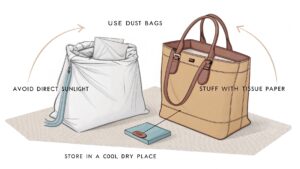Do you have handbags piling up in your closet? Storing them the right way can save you space and keep them in perfect condition.
Storing handbags properly involves using dust bags, avoiding direct sunlight, and keeping them in a cool, dry place. You should also stuff them with tissue paper to maintain their shape and prevent creasing.

Now, let’s dive deeper into the specifics to ensure your handbags remain pristine for years to come.
What is the proper way to store handbags?
Are you worried about damaging your handbags while storing them? Following the right steps can keep them safe.
The proper way to store handbags includes using dust bags, avoiding direct sunlight, stuffing them with tissue paper, and keeping them in a cool, dry place to prevent damage and maintain their shape.

Why is Proper Storage Important?
Proper storage is essential to prevent your handbags from losing their shape, getting damaged, or fading. Here are some detailed steps to follow:
- Use Dust Bags: Always store your handbags in their original dust bags. If you don’t have one, use a soft, breathable fabric bag. This protects them from dust and scratches.
- Stuff with Tissue Paper: Fill the handbag with acid-free tissue paper to maintain its shape. This prevents creasing and keeps the structure intact.
- Avoid Direct Sunlight: Keep your handbags away from direct sunlight to prevent fading and discoloration. UV rays can damage the material over time.
- Keep in a Cool, Dry Place: Humidity can cause mold and mildew, so store your handbags in a cool, dry place. Use silica gel packets to absorb excess moisture.
How to store handbags when not in use?
Do you have handbags you don’t use often? Storing them correctly ensures they’re ready when you need them.
When not in use, handbags should be stored in dust bags, stuffed with tissue paper, and kept in a cool, dry place. Avoid hanging them to prevent stretching.

Detailed Tips for Long-Term Storage
Storing handbags when not in use requires special attention to ensure they remain in perfect condition:
- Avoid Hanging: Hanging handbags can cause the handles to stretch or deform over time. Instead, lay them flat or place them upright.
- Rotate Storage: If you have multiple handbags, rotate their storage to prevent long-term pressure on one bag.
- Regular Checkups: Periodically check stored handbags for any signs of damage or mold. Air them out if necessary.
- Use Silica Gel: Place silica gel packets inside the storage area to keep moisture levels low.
How to store handbags with no space?
Running out of space for your handbags? Here are some clever ways to store them efficiently.
To store handbags with no space, consider using hooks, shelves, or over-the-door organizers. Vertical storage solutions can save space and keep your handbags accessible.

Space-Saving Storage Solutions
Limited space doesn’t mean you have to compromise on storing your handbags properly. Here are some effective solutions:
- Over-the-Door Organizers: These organizers can hold multiple handbags without taking up floor space. They’re perfect for small closets or bedrooms.
- Shelves and Hooks: Install shelves or hooks on walls to hang handbags. Make sure they’re sturdy enough to hold the weight.
- Stacking Bins: Use clear plastic bins to stack handbags vertically. Label each bin for easy access and to prevent squishing.
- Under-Bed Storage: Store handbags in shallow under-bed storage boxes. This keeps them out of sight but easily accessible.
What is the best material to store handbags?
What material should you use to store your handbags for maximum protection?
The best materials to store handbags are soft, breathable fabrics like cotton or felt. Avoid plastic as it can trap moisture and cause damage.

Choosing the Right Storage Material
The material you use to store your handbags can significantly impact their longevity. Here’s a breakdown:
| Material | Pros | Cons |
|---|---|---|
| Cotton | Breathable, soft, prevents dust | May require frequent washing |
| Felt | Soft, protective, prevents scratches | Can be bulky |
| Plastic | Cheap, transparent | Traps moisture, can cause damage |
| Silk | Luxurious, soft | Expensive, not highly protective |
Opt for cotton or felt dust bags for the best protection. These materials allow air circulation, preventing mold and mildew, and are gentle on the handbag’s surface.
Conclusion
Storing handbags properly ensures they stay in great condition, saves space, and keeps them ready for use. Follow these tips to protect your investment.

